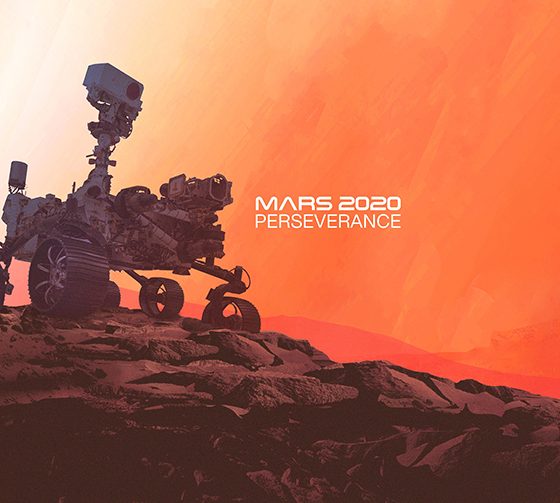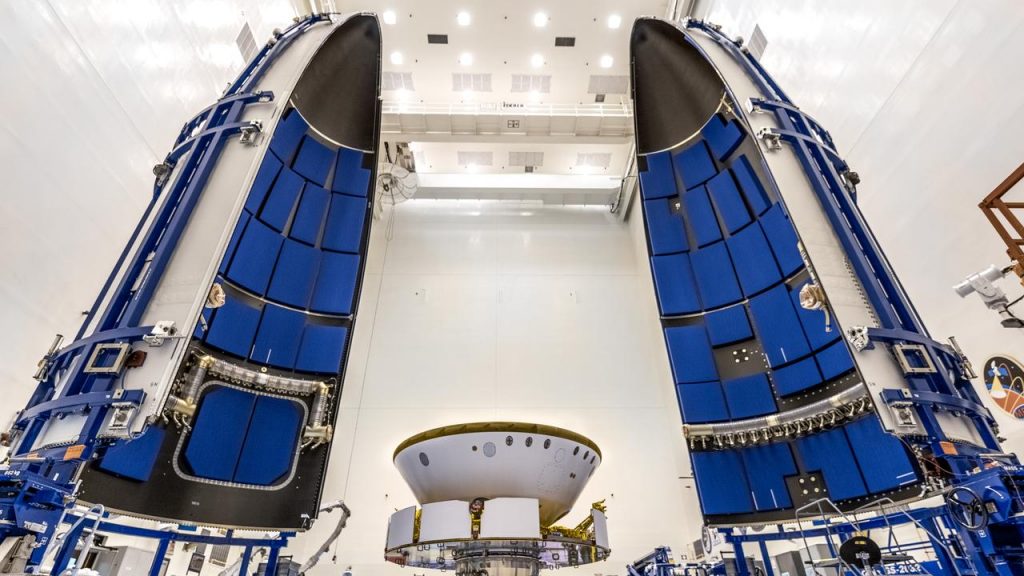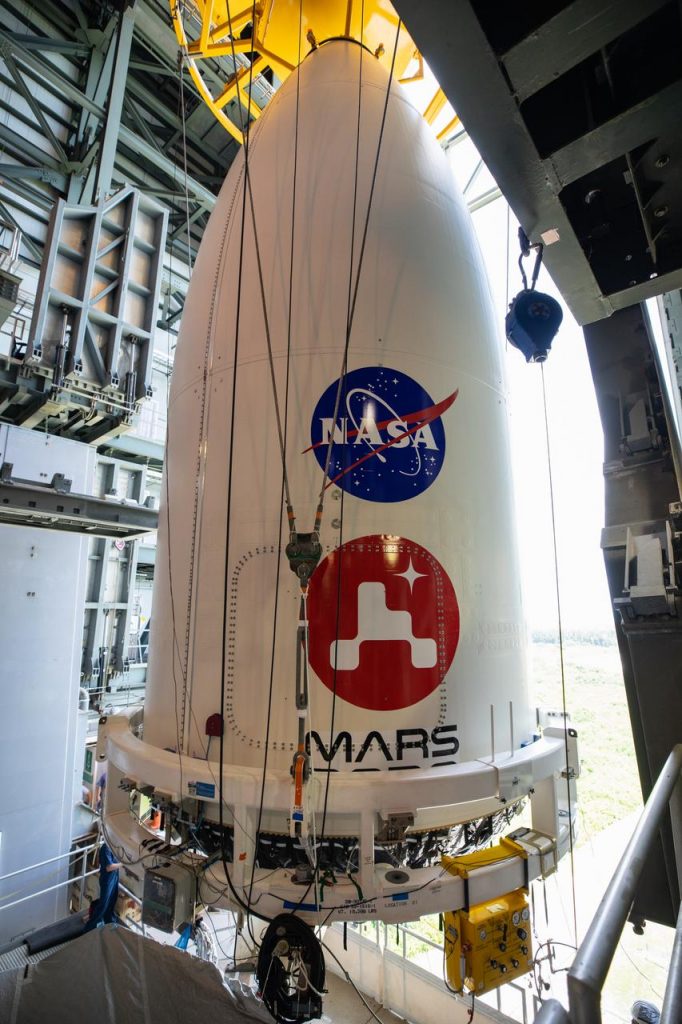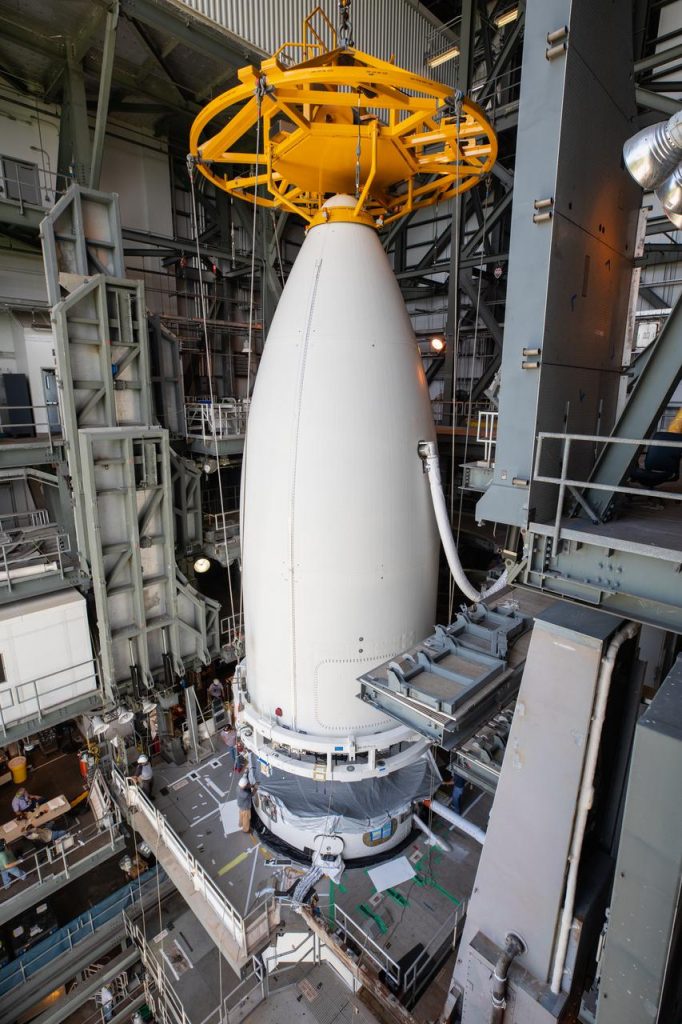

News
NASA set for upcoming Mars mission to seek signs of ancient life on the red planet
Just three weeks ahead of liftoff, NASA and launch provider United Launch Alliance (ULA) announced that NASA’s Mars 2020 rover, Perseverance, and its Martian helicopter sidekick, Ingenuity, were mated with the Atlas V 541 rocket that will kick off the seven-month journey to the Red Planet. The precious cargo encapsulated inside of a protective payload fairing was carefully hoisted by crane operators to rest atop the Atlas V rocket. The payload joins the Atlas V common core booster, four solid rocket boosters, and the Centaur upper stage to achieve the stack’s final flight configuration height of 197 feet (60 meters).


The United Launch Alliance (ULA) payload fairing with NASA’s Mars 2020 Perseverance rover secured inside is positioned on top of the ULA Atlas V rocket inside the Vertical Integration Facility (VIF) at Space Launch Complex 41 at Cape Canaveral Air Force Station in Florida on July 7, 2020. (Image Credit: NASA/Kim Shiflett)
The final stacking procedure was completed inside of the Vertical Integration Facility (VIF) at Cape Canaveral Air Force Station’s Space Launch Complex 41 (SLC-41). The rocket and payload will remain inside the protective structure and complete final check out tests until it is time quite literally roll to the launchpad. Crane operators first set down the payload for a soft touch to begin final full physical and electrical connection. The spacecraft and rocket will undergo integrated electrical testing as well as a battery of other tests as separate spacecraft and simultaneously as one complete unit.
On Friday (July 10), ULA president and chief executive officer, Tory Bruno, stated on Twitter that the Integrated Systems Test (IST) had been completed successfully. According to a previous mission statement posted to the ULA blog site, the IST is a typical pre-launch run down of the various connected systems between the spacecraft and launch vehicle to “verify proper functionality of launch vehicle systems, (and) conduct a simulated countdown and run through the launch sequence.”
The launch vehicle and integrated payload will remain inside the VIF undergoing mission-specific activities and final system checkouts over the next two weeks. Once all pre-flight activities have been successfully completed, approximately two days ahead of the scheduled launch attempt, the entire stack located on top of the Mobile Launch Platform will make the 1,800ft (550 meters) trip to the SLC-41 launchpad which will take about forty-minutes on a modified railway.

Known as an astrobiology mission and outfitted with seven instruments, the Perseverance rover will conduct new science, sample collection, and test new technology in search of ancient microbial life on the distant planet. The rover will spend the length of one Martian year – two Earth years – exploring the region around its landing site. It will collect and cache samples of the Martian surface to possibly be collected and returned to Earth by future joint missions currently under consideration by NASA and the European Space Agency.

The first interplanetary helicopter, Ingenuity, is a small 4-pound (1.8 kilograms) autonomous solar-powered aircraft that will conduct a series of experimental test flights. Ingenuity is traveling to Mars solely for a demonstrative mission and is not connected to the Perseverance rover by any means other than hitching a ride to the Red Planet. The new technology will demonstrate an ability to create lift in the thin atmosphere and lower gravity environment of Mars to help inform future aerial exploration and science delivery missions.
Currently, NASA and ULA are targeting the launch of the interplanetary mission on July 30th at 7:50 am EDT/4:50 PDT. Should they be necessary, multiple backup launch opportunities are available until the close of the interplanetary launch window on August 15th. Regardless of the launch date, after a seven-month-long, 290 million mile (467 million kilometers) journey – the rover and helicopter will arrive at Mars’s Jezero Crater, the home to an ancient Martian river delta, for a landing attempt on February 18, 2021. The landing date is perhaps even more crucial than the launch date as mission planners must take into account landing site lighting and temperature conditions and the locations of Mars-orbiting satellites required to relay crucial mission-specific information back to Earth.
Should the launch have to abort, and the 2020 window is missed completely, the robots will have to wait until 2022 when Earth’s orbit lines up just right with that of Mars, and the next interplanetary launch window opens up.

News
Elon Musk’s Grokipedia surges to 5.6M articles, almost 79% of English Wikipedia
The explosive growth marks a major milestone for the AI-powered online encyclopedia, which was launched by Elon Musk’s xAI just months ago.

Elon Musk’s Grokipedia has grown to an impressive 5,615,201 articles as of today, closing in on 79% of the English Wikipedia’s current total of 7,119,376 articles.
The explosive growth marks a major milestone for the AI-powered online encyclopedia, which was launched by Elon Musk’s xAI just months ago. Needless to say, it would only be a matter of time before Grokipedia exceeds English Wikipedia in sheer volume.
Grokipedia’s rapid growth
xAI’s vision for Grokipedia emphasizes neutrality, while Grok’s reasoning capabilities allow for fast drafting and fact-checking. When Elon Musk announced the initiative in late September 2025, he noted that Grokipedia would be an improvement to Wikipedia because it would be designed to avoid bias.
At the time, Musk noted that Grokipedia “is a necessary step towards the xAI goal of understanding the Universe.”
Grokipedia was launched in late October, and while xAI was careful to list it only as Version 0.1 at the time, the online encyclopedia immediately earned praise. Wikipedia co-founder Larry Sanger highlighted the project’s innovative approach, noting how it leverages AI to fill knowledge gaps and enable rapid updates. Netizens also observed how Grokipedia tends to present articles in a more objective manner compared to Wikipedia, which is edited by humans.
Elon Musk’s ambitious plans
With 5,615,201 total articles, Grokipedia has now grown to almost 79% of English Wikipedia’s article base. This is incredibly quick, though Grokipedia remains text-only for now. xAI, for its part, has now updated the online encyclopedia’s iteration to v0.2.
Elon Musk has shared bold ideas for Grokipedia, including sending a record of the entire knowledge base to space as part of xAI’s mission to preserve and expand human understanding. At some point, Musk stated that Grokipedia will be renamed to Encyclopedia Galactica, and it will be sent to the cosmos.
“When Grokipedia is good enough (long way to go), we will change the name to Encyclopedia Galactica. It will be an open source distillation of all knowledge, including audio, images and video. Join xAI to help build the sci-fi version of the Library of Alexandria!” Musk wrote, adding in a later post that “Copies will be etched in stone and sent to the Moon, Mars and beyond. This time, it will not be lost.”
News
Tesla Model 3 becomes Netherlands’ best-selling used EV in 2025
More than one in ten second-hand electric cars sold in the country last year was a Tesla Model 3.

The Tesla Model 3 became the most popular used electric car in the Netherlands in 2025, cementing its dominance well beyond the country’s new-car market.
After years at the top of Dutch EV sales charts, the Model 3 now leads the country’s second-hand EV market by a wide margin, as record used-car purchases pushed electric vehicles further into the mainstream.
Model 3 takes a commanding lead
The Netherlands recorded more than 2.1 million used car sales last year, the highest level on record. Of those, roughly 4.8%, or about 102,000 vehicles, were electric. Within that growing segment, the Tesla Model 3 stood far ahead of its competitors.
In 2025 alone, 11,338 used Model 3s changed hands, giving the car an 11.1% share of the country’s entire used EV market. That means more than one in ten second-hand electric cars sold in the country last year was a Tesla Model 3, Auto Week Netherlands reported. The scale of its lead is striking: the gap between the Model 3 and the second-place finisher, the Volkswagen ID3, is more than 6,700 vehicles.
Rivals trail as residual values shape rankings
The Volkswagen ID.3 ranked a distant second, with 4,595 used units sold and a 4.5% market share. Close behind was the Audi e-tron, which placed third with 4,236 registrations. As noted by Auto Week Netherlands, relatively low residual values likely boosted the e-tron’s appeal in the used market, despite its higher original price.
Other strong performers included the Kia Niro, the Tesla Model Y, and the Hyundai Kona, highlighting continued demand for compact and midsize electric vehicles with proven range and reliability. No other model, however, came close to matching the Model 3’s scale or market presence.
News
Tesla Model Y Standard Long Range RWD launches in Europe
The update was announced by Tesla Europe & Middle East in a post on its official social media account on X.

Tesla has expanded the Model Y lineup in Europe with the introduction of the Standard Long Range RWD variant, which offers an impressive 657 km of WLTP range.
The update was announced by Tesla Europe & Middle East in a post on its official social media account on X.
Model Y Standard Long Range RWD Details
Tesla Europe & Middle East highlighted some of the Model Y Standard Long Range RWD’s most notable specs, from its 657 km of WLTP range to its 2,118 liters of cargo volume. More importantly, Tesla also noted that the newly released variant only consumes 12.7 kWh per 100 km, making it the most efficient Model Y to date.
The Model Y Standard provides a lower entry point for consumers who wish to enter the Tesla ecosystem at the lowest possible price. While the Model 3 Standard is still more affordable, some consumers might prefer the Model Y Standard due to its larger size and crossover form factor. The fact that the Model Y Standard is equipped with Tesla’s AI4 computer also makes it ready for FSD’s eventual rollout to the region.
Top Gear’s Model Y Standard review
Top Gear‘s recent review of the Tesla Model Y Standard highlighted some of the vehicle’s most notable features, such as its impressive real-world range, stellar infotainment system, and spacious interior. As per the publication, the Model Y Standard still retains a lot of what makes Tesla’s vehicles well-rounded, even if it’s been equipped with a simplified interior.
Top Gear compared the Model Y Standard to its rivals in the same segment. “The introduction of the Standard trim brings the Model Y in line with the entry price of most of its closest competition. In fact, it’s actually cheaper than a Peugeot e-3008 and costs £5k less than an entry-level Audi Q4 e-tron. It also makes the Ford Mustang Mach-E look a little short with its higher entry price and worse range,” the publication wrote.








